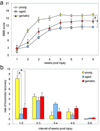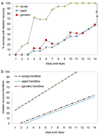Myelin pathogenesis and functional deficits following SCI are age-associated
- PMID: 18644369
- PMCID: PMC3445440
- DOI: 10.1016/j.expneurol.2008.06.015
Myelin pathogenesis and functional deficits following SCI are age-associated
Abstract
Most spinal cord injuries (SCI) occur in young adults. In the past few decades however, the average age at time of SCI and the percentage of injuries in persons over the age of 60 have increased. Studies have shown that there is an age-associated delay in the rate of remyelination following toxin-induced demyelination of the spinal cord, suggesting that there may be an age-associated difference in regenerative efficiency. Here we examine for the first time locomotor recovery, bladder recovery, and myelin pathology in young (3 months), aged (12 months), and geriatric (24 months) female rats following contusion SCI. Our assessments indicate that aged and geriatric rats have a delayed rate of locomotor recovery following contusion SCI as compared to young rats. Additionally, aged and geriatric rats have significantly slower bladder recovery as compared to young rats. Examination of myelin pathology reveals that aged and geriatric rats have significantly greater area of pathology and amount of demyelination, as well as significantly less remyelination as compared to young rats following contusion SCI. These data are the first to indicate that there is an age-associated decline in the rate and extent of both locomotor and bladder recovery following contusion SCI, and that age adversely affects the degree of general pathology, demyelination, and remyelination that accompanies contusion SCI.
Figures






Similar articles
-
Voluntary running attenuates age-related deficits following SCI.Exp Neurol. 2008 Mar;210(1):207-16. doi: 10.1016/j.expneurol.2007.10.019. Epub 2007 Nov 13. Exp Neurol. 2008. PMID: 18164294 Free PMC article.
-
The extent of myelin pathology differs following contusion and transection spinal cord injury.J Neurotrauma. 2007 Oct;24(10):1631-46. doi: 10.1089/neu.2007.0302. J Neurotrauma. 2007. PMID: 17970626
-
Delayed transplantation of adult neural precursor cells promotes remyelination and functional neurological recovery after spinal cord injury.J Neurosci. 2006 Mar 29;26(13):3377-89. doi: 10.1523/JNEUROSCI.4184-05.2006. J Neurosci. 2006. PMID: 16571744 Free PMC article.
-
Myelin status and oligodendrocyte lineage cells over time after spinal cord injury: What do we know and what still needs to be unwrapped?Glia. 2019 Nov;67(11):2178-2202. doi: 10.1002/glia.23702. Epub 2019 Aug 24. Glia. 2019. PMID: 31444938 Free PMC article. Review.
-
Axonal degeneration and demyelination following traumatic spinal cord injury: A systematic review and meta-analysis.J Chem Neuroanat. 2019 Apr;97:9-22. doi: 10.1016/j.jchemneu.2019.01.009. Epub 2019 Feb 3. J Chem Neuroanat. 2019. PMID: 30726717
Cited by
-
Enhanced Functional Recovery from Spinal Cord Injury in Aged Mice after Stem Cell Transplantation through HGF Induction.Stem Cell Reports. 2017 Mar 14;8(3):509-518. doi: 10.1016/j.stemcr.2017.01.013. Epub 2017 Feb 16. Stem Cell Reports. 2017. PMID: 28216143 Free PMC article.
-
Molecular pathology of acute spinal cord injury in middle-aged mice.bioRxiv [Preprint]. 2025 May 14:2025.05.08.652873. doi: 10.1101/2025.05.08.652873. bioRxiv. 2025. Update in: J Neuroinflammation. 2025 Jul 13;22(1):181. doi: 10.1186/s12974-025-03494-4. PMID: 40463189 Free PMC article. Updated. Preprint.
-
A quantitative analysis of clinical trial designs in spinal cord injury based on ICCP guidelines.J Neurotrauma. 2012 Jun 10;29(9):1736-46. doi: 10.1089/neu.2011.2162. Epub 2012 Apr 2. J Neurotrauma. 2012. PMID: 22369673 Free PMC article. Review.
-
The Influence of Neuron-Extrinsic Factors and Aging on Injury Progression and Axonal Repair in the Central Nervous System.Front Cell Dev Biol. 2020 Mar 25;8:190. doi: 10.3389/fcell.2020.00190. eCollection 2020. Front Cell Dev Biol. 2020. PMID: 32269994 Free PMC article. Review.
-
Characterization of recovery, repair, and inflammatory processes following contusion spinal cord injury in old female rats: is age a limitation?Immun Ageing. 2014 Oct 29;11:15. doi: 10.1186/1742-4933-11-15. eCollection 2014. Immun Ageing. 2014. PMID: 25512759 Free PMC article.
References
-
- Azcoitia I, Sierra A, Veiga S, Garcia-Segura LM. Aromatase expression by reactive astroglia is neuroprotective. Ann N Y Acad Sci. 2003;1007:298–305. - PubMed
-
- Bartzokis G. Age-associated myelin breakdown: a developmental model of cognitive decline and Alzheimer's disease. Neurobiol Aging. 2004;25:5–18. author reply 49–62. - PubMed
-
- Basso DM, Beattie MS, Bresnahan JC. A sensitive and reliable locomotor rating scale for open field testing in rats. J Neurotrauma. 1995;12:1–21. - PubMed
-
- Blight AR. Remyelination, revascularization, and recovery of function in experimental spinal cord injury. Adv Neurol. 1993;59:91–104. - PubMed
Publication types
MeSH terms
Grants and funding
LinkOut - more resources
Full Text Sources
Medical
Miscellaneous

